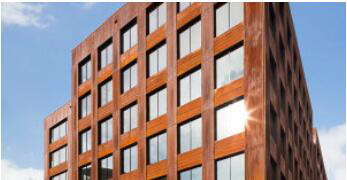
While most cities are known for skyscrapers made of steel buildings, wood may soon reshape the landscape of some of the country's biggest concrete jungles. A number of development companies are exploring a new kind of high-rise structure built entirely from timber. WIRED's Liz Stinson discuses the use of timber as a building material:
Wood isn’t new, of course. Up until the late 19th century, timber was still the dominant building material. That changed after a series of brutal city fires tore through major American cities, showcasing wood’s flammability and encouraging architects to explore new materials like steel and concrete. But new innovations have made wood more attractive again. Take cross-laminated timber, a kind of super-strong plywood, made by gluing together different pieces of wood to form a layered composite that rivals the strength of steel. This new material, paired with precision digital manufacturing processes like CNC milling, allows architects to build with timber at heights unimaginable a century ago. And its environmental properties make it even more attractive; wood acts like a lock box for carbon dioxide, sequestering excess CO2 from the air.
Researchers at Cambridge University have partnered with architecture firm Perkins + Will to explore the use of timber as a new building material. Their concept project, The River Beech Tower in Chicago, is a "spindly, beechwood building whose 80 stories cut a blonde silhouette against Chicago’s dark, glassy horizon." Researchers from the project looked for guidance from previously built timber structures, such as T3 in Minneapolis, The Oakwood Tower in London, and the 18-story Brock Commons building in Vancouver.
“I would look at Brock Commons as a demonstration of using a product to a height that’s attainable, a timeline that’s quick, and one that’s very economically viable,” says Robert Jackson, a structural engineer at Fast + Epp who worked on the project.
Michael Ramage, head of Cambridge University’s Center for Natural Material Innovation and a lead engineer on Chicago’s River Beech tower and London’s Oakwood Tower, says that Brock Commons represents a first step toward discovering timber’s unique potential. “There’s a history of material replacement that you can trace every time we change a major building material,” he says. “We copy the previous material until we master the new one.” This happened with iron, steel, and concrete. Eventually, Ramage believes, architects will embrace wood’s singular properties to come up with intriguing new forms.









Service Hotline
Work Time:Mon-Fri 9:00-18:00
UTC+8

Sinoexpo Digital Platform
Copyright 2006-2024 Shanghai Sinoexpo Informa Markets International Exhibition Co., Ltd. All rights reserved
沪ICP备05034851号-77
 沪公网安备 31010402000543号
沪公网安备 31010402000543号